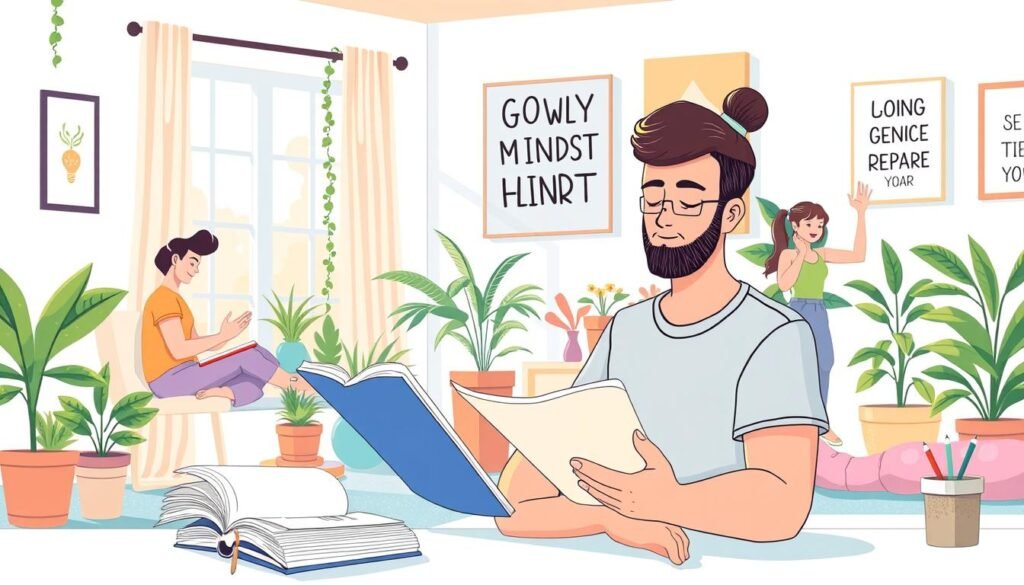What if the key to unlocking your greatest achievements lies not in talent or luck, but in how you view your own abilities? At Strobel Education, we’ve seen firsthand how adopting new perspectives can reshape careers, relationships, and personal fulfillment. This approach—rooted in continuous learning—turns obstacles into stepping stones and “I can’t” into “I’ll try.”
Your beliefs about your skills directly shape what you accomplish. Studies show people who see challenges as opportunities tend to achieve more in work, education, and life. The good news? This isn’t about natural talent—it’s about cultivating resilient thinking patterns anyone can learn.
Whether you’ve faced setbacks or steady progress, this guide offers practical steps to shift from self-doubt to empowerment. You’ll discover how to reframe failures as feedback, build confidence through small wins, and maintain momentum even when progress feels slow.
Key Takeaways
- Your core beliefs determine your capacity to learn and adapt
- Challenges become valuable when viewed through a flexible perspective
- Progress stems from consistent effort, not innate talent
- Practical strategies can rewire thought patterns at any age
- Every experience offers hidden lessons for improvement
Introduction to Growth Mindset
Success isn’t about where you start—it’s about believing you can evolve beyond current limitations. This core philosophy transforms how people approach challenges, turning “I’m not good at this” into “What can I learn?”
A growth mindset rejects the idea that intelligence or talent are fixed traits. Instead, it treats them like muscles that strengthen with exercise. Research shows this perspective helps individuals:
- Persist through difficult tasks 50% longer
- Recover faster from setbacks
- Consistently outperform peers with rigid self-views
This approach isn’t wishful thinking. It’s a practical framework for measurable progress. People who adopt this mental model stop seeing mistakes as failures. They start viewing them as course corrections on their improvement journey.
Consider how two coworkers might handle criticism. One becomes defensive (fixed thinking). The other asks clarifying questions (growth thinking). Over time, this difference creates massive gaps in skill development and career advancement.
Whether mastering a new language or leading a team, this perspective turns daily experiences into stepping stones. It’s not magic—it’s making consistent effort your superpower.
Understanding Fixed and Growth Mindsets
The lens through which you view obstacles determines whether they become barriers or stepping stones. At its core, mindset shapes how we interpret effort, feedback, and setbacks. Let’s unpack two distinct approaches that define personal and professional trajectories.
Defining a Fixed Mindset
People with a fixed mindset see skills as unchangeable traits. They might think, “I’m just not math-minded” or “Art isn’t my thing.” This belief system leads to avoiding challenges where natural talent isn’t obvious. Studies show these individuals often:
- Fear criticism
- Give up easily
- Feel threatened by others’ success
Characteristics of a Growth Mindset
In contrast, those with a growth mindset treat skills like clay—moldable through practice. They ask, “What can I learn here?” rather than worrying about looking smart. Key traits include:
- Seeking feedback actively
- Persisting through difficulties
- Celebrating progress in others
Consider a student struggling with algebra. Fixed thinkers might drop the class. Growth-oriented learners would request extra practice problems. This difference in approach often predicts who eventually masters the subject.
Developing a Growth Mindset for Long-Term Success
Lasting achievement starts with reshaping how you perceive effort and outcomes. Unlike temporary fixes, this approach turns daily actions into stepping stones toward meaningful progress. Consistent practice becomes your compass, guiding you through challenges rather than avoiding them.
- Viewing setbacks as data points for improvement
- Prioritizing learning over immediate perfection
- Celebrating incremental progress as meaningful wins
Research reveals people who embrace this approach show 72% higher perseverance in tough projects. They ask better questions after mistakes and build stronger networks through collaborative learning. “What worked?” and “What’s next?” replace self-judgment.
This journey thrives on curiosity. Instead of fearing unfamiliar tasks, you’ll start seeing them as skill-building adventures. Over time, challenges become invitations to expand your capabilities rather than threats to your confidence.
By reframing obstacles as growth opportunities, you create sustainable momentum. The result? A flexible perspective that turns everyday experiences into launchpads for continuous improvement.
Benefits of Adopting a Growth Mindset
How you approach obstacles could be the difference between stagnation and breakthrough. People who embrace flexible thinking patterns unlock hidden advantages in both personal and professional life. This perspective turns everyday experiences into fuel for continuous improvement.

Enhancing Personal Growth and Confidence
When challenges arise, they become chances to build new skills instead of threats to avoid. “What can this teach me?” replaces “Why is this happening to me?” This shift helps people recover from setbacks 40% faster according to Stanford research.
Confidence grows naturally when you focus on progress over perfection. Instead of worrying about looking smart, you start valuing the learning process itself. Small wins accumulate into unshakable self-trust that survives temporary failures.
This approach also strengthens relationships. Teams using growth-oriented language solve problems 28% faster than fixed-mindset groups. Leaders who model curiosity inspire others to take smart risks and share ideas freely.
Best part? These benefits compound over time. Each challenge tackled builds mental muscle for the next one. You stop chasing quick fixes and start building lasting capabilities through deliberate practice.
Overcoming a Fixed Mindset: Strategies and Tips
What stories do you tell yourself when facing tough tasks? Many people unknowingly limit their potential by clinging to rigid self-views. Breaking free starts with honest self-reflection and deliberate action.
Acknowledging Limitations
Spotting fixed mindset patterns requires gentle honesty. Notice thoughts like “I’ll never be good at this” or avoiding tasks where you might struggle. These mental habits often stem from fear of looking incompetent.
Try this: Journal for one week about situations where you felt defensive or stuck. Look for common triggers. Awareness creates space to choose different responses next time.
Embracing Challenges and Learning from Mistakes
Challenges become less scary when viewed as skill-building games. Start small—tackle a task 10% outside your comfort zone. If you stumble, ask: “What does this teach me?” instead of “Why did I fail?”
Great innovators reframe failure as prototyping. Thomas Edison famously said, “I haven’t failed. I’ve found 10,000 ways that don’t work.” Each attempt builds knowledge that textbooks can’t provide.
When nervous about taking risks, remind yourself: Growth happens in the trying, not just the winning. Celebrate effort regardless of outcome—this builds resilience for bigger challenges ahead.
Practical Steps for Daily Growth Mindset Development
Building mental flexibility requires more than good intentions—it needs a roadmap. Start by treating each day as a lab for experimentation, where curiosity drives progress and setbacks become data points. This approach turns abstract concepts into tangible actions.

Cultivating Self-Awareness
Notice your inner voice during challenging moments. When frustration arises, pause and ask: “Is this thought helping me learn?” Jot down reactions in a journal to spot patterns. Over time, you’ll catch fixed thinking faster and pivot to solution-focused questions.
Setting Achievable Goals and Celebrating Small Wins
Break big aspirations into weekly goals that stretch skills without overwhelming. Completed a 15-minute practice session? That’s progress. Finished a tough project phase? Mark it. These micro-celebrations rewire your brain to value the process over perfection.
Integrating Continuous Learning Habits
Pair daily routines with skill-building. Listen to educational podcasts during commutes or discuss new ideas with colleagues. One teacher increased her students’ engagement by 60% using “feedback Fridays”—dedicating 10 minutes weekly to discuss improvements.
Remember: Sustainable change happens through repetition, not revolution. Track efforts in a simple app or calendar, reviewing wins every Sunday. Missed a day? That’s part of the learning curve. What matters is returning to the goals with fresh energy tomorrow.
Real-Life Examples: Learning from Success Stories
History’s most celebrated achievers often share one trait: They turned apparent weaknesses into strengths through relentless effort. Let’s examine two iconic figures who transformed setbacks into legendary comebacks.
Steve Jobs: Innovation Through Resilience
After leaving college, Jobs spent nights sleeping on friends’ floors while auditing calligraphy classes. This unconventional path later inspired Apple’s revolutionary typography. When ousted from his own company in 1985, he founded NeXT—a venture whose tech became iOS’s foundation.
Jobs’ secret? Treating failures as skill-building detours. “You can’t connect the dots looking forward,” he noted in his Stanford speech. Each setback taught him to refine products and leadership strategies, proving that dedication outshines initial disadvantages.
Michael Jordan: Mastering Skills Through Persistent Effort
Cut from his high school team at 15, Jordan used rejection as fuel. He practiced 3+ hours daily before school, developing the work ethic that earned six NBA championships. His hard work became legendary—once scoring 63 points despite battling the flu during the 1997 Finals.
Jordan’s philosophy? “I’ve missed more than 9,000 shots. That’s why I succeed.” His story shows how effort rewrites limitations into triumphs.
| Challenge Faced | Action Taken | Outcome Achieved |
|---|---|---|
| College dropout (Jobs) | Studied design principles informally | Created user-friendly tech interfaces |
| High school rejection (Jordan) | Added 2 hours of daily practice | Became 5x NBA MVP |
| Corporate exile (Jobs) | Developed new operating system | Returned to Apple with iOS 1.0 |
These stories prove that skills grow through persistent effort—not innate talent. Whether in tech or sports, sustained hard work builds legacies that inspire generations.
Cultivating a Growth Mindset in Professional Settings
Modern workplaces thrive when teams view challenges as skill-building puzzles rather than roadblocks. Leaders who prioritize learning over perfection create environments where innovation flourishes. Growth mindset principles help colleagues reframe tight deadlines as creativity boosters and client feedback as improvement roadmaps.
Effective managers model curiosity by asking, “What can we try differently next quarter?” instead of focusing solely on results. This approach encourages teams to share ideas without fear of judgment. One tech company saw 34% faster problem-solving after training managers to celebrate effort alongside outcomes.
Challenge assumptions about others by creating cross-training opportunities. A sales team might rotate roles monthly—account managers handling client support, reps analyzing data. This breaks down fixed beliefs about who can excel in specific work areas.
| Strategy | Fixed Mindset Approach | Growth Mindset Alternative |
|---|---|---|
| Performance Reviews | “You’re not leadership material” | “Let’s build your delegation skills” |
| Project Setbacks | “This team always misses targets” | “What adjustments will help us succeed?” |
| New Initiatives | “Stick to what works” | “Prototype three options by Friday” |
Constructive feedback becomes a growth tool when framed as, “Here’s how to strengthen this proposal,” rather than generic praise or criticism. Regular skill-sharing lunches and peer mentoring programs help others recognize their untapped potential. Remember: Cultures that value progress over perfection attract top talent and drive lasting results.
Developing Resilience and Embracing Challenges
What separates those who bounce back from setbacks? It’s not avoiding storms—it’s learning to dance in the rain. When challenges arise, they become chances to uncover hidden strengths. Imagine staring at a mountain you’re scared to climb. Now picture it as a playground for discovering new skills.
Redefining Risk and Reward
Great achievements often start with uneasy first steps. Taking smart risks means asking, “What’s the best that could happen?” instead of fearing worst-case scenarios. A manager might view a missed promotion as a chance to build leadership skills elsewhere. An artist could turn rejected work into a new creative direction.
Fear of failure shrinks when you treat missteps as feedback. Think of toddlers learning to walk—they fall dozens of times but never label themselves “bad at walking.” Each attempt builds balance and courage. Adults can adopt this mindset by celebrating effort over perfect outcomes.
Try this reframe: Next time stress hits, whisper, “This is my hero moment.” You’ll often find untapped reserves of grit and creativity. Over time, challenges stop feeling like threats and start looking like opportunities to level up.

![[developing a growth mindset for long-term success]](https://upgrademyfocus.com/wp-content/uploads/2025/07/developing-a-growth-mindset-for-long-term-success.jpeg)